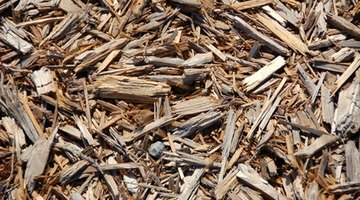How to Install Jute Netting
Jute netting is ideal for erosion control, especially when laid over a layer of mulch. The jute helps stabilize the mulch, and together they provide a series of small impediments to water flow, thus inhibiting erosion.

Things You Will Need
- Shovel or trenching tool
- Jute netting, equal in size to the area you are mulching with a 4-inch overlap between sheets
- Galvanized anchor "J" pins, at least 10 inches long, or galvanized staples, at least 6 inches long
- Mallet (optional)
You can install jute netting in erosion-prone areas such as a newly cut bank or a slope where fire has cleared away vegetation. To work properly, however, jute netting must be laid out and anchored properly.
-
Dig a trench at least 8 inches deep all the way across the top of the mulched slope where you will install the netting; the U.S. Department of Agriculture's National Resources Conservation Service recommends extending this trench about a foot on either side.
-
Unroll the first section of jute netting lengthwise down the slope, leaving enough at the top to extend through the trench and 6 inches beyond. In severe erosion conditions, extend the rolls 3 feet beyond the bottom of the mulched area.
-
Unroll the second section of jute netting in the same direction. Overlap parallel sides (lengthwise) by at least 4 inches; overlap ends by 3 feet.
-
Repeat Step 3 until the entire surface is covered.
-
Fill in the trench at the top of the slope, burying a section of netting, and step on the replaced soil to compact it into the trench.
-
Drive the anchor pins or staples straight down into the soil no more than 1 foot apart across the top of the netting at the top of the slope, catching an intersection of the jute beneath the bent top as you do so. In hard, dry soils, you may need a mallet to drive them fully in.
-
Drive anchor pins or staples into the rest of the netting using the same technique. Across every overlapping end, space them no more than 1 foot apart; down the overlapping long sides, space them no more than 5 feet apart. If the roll is more than 3 feet wide, place pins or anchors down the center of the rolls, no more than 5 feet apart.
Tip
When calculating the amount of netting and number of pins or staples you need, remember to take account of the recommended overlaps. In sandy soils, use longer pins or anchors, because they can work loose. While jute netting is used most frequently on slopes, you can also use it on flat ground to reduce dust and to hold down seeding mats or mulches.
Warning
Jute netting is widely useful, but it is not appropriate to every situation; writing for Washington State University, M.E. Stannard, et al., warn that jute netting is not suitable for steep sandy or rocky slopes or fire-burned areas with much of the scorched vegetation remaining.
References
Resources
Writer Bio
Jennifer Spirko has been writing professionally for more than 20 years, starting at "The Knoxville Journal." She has written for "MetroPulse," "Maryville-Alcoa Daily Times" and "Some" monthly. She has taught writing at North Carolina State University and the University of Tennessee. Spirko holds a Master of Arts from the Shakespeare Institute, Stratford-on-Avon, England.
Photo Credits
- pine bark mulch image by robert mobley from Fotolia.com
- pine bark mulch image by robert mobley from Fotolia.com
More Articles



